The Who, What, When, Where, Why and How About Going Native in the Backyard – Technologist
Republished with permission from ClearWater Conservancy. All photos courtesy of the author.
Creating Networks of Habitats to Support Wildlife from the Little Things on Up
By Suzy Yetter, Staff Ecologist with ClearWater Conservancy
Back in 2015, my husband and I moved across the fence row onto ten acres of land next to the family farm in Union County. Prior to this, the area had been farmed and eventually served as a wet cow pasture that was later abandoned, transitioning into an old field community. The previous resident liked to take occasional walks through the meadow and had mowed a series of crisscrossing paths but had otherwise allowed nature to take over everywhere else. Twenty years later, my husband and I encountered thick grass in the mowed paths and thickets of multiflora rose, bush honeysuckle, and autumn olive everywhere else. Remnant clumps of arrowwood and dogwood shrubs were scattered throughout with patches of goldenrod, ironweed, sedges and rushes in between. Walnuts and locust trees were everywhere, too.
 At the time, I was working at Penn State doing wetland and stream assessments with only a smattering of knowledge about how to turn my new home into a native, horticultural oasis for me and the critters around me. I had seen the damage invasive species could do, crowding out native species in wetlands and floodplains and had developed a hearty dislike for particular species, like multiflora rose, after spending many a day crawling on my hands and knees through dense thickets of it to lay transects. I still had a lot to learn, though, about how to control invasive species in my own back yard. Armed with nothing but a pair of loppers and a shovel, I set out to immediately eradicate any thornbush or other invasive plant that I found. Several days and one aching back later, I felt a deep sense of accomplishment and satisfaction as I looked around at the tiny area that had once been a tangle of thorns but now had been cleared to reveal the native arrowwoods and elderberries that had been hiding underneath.
At the time, I was working at Penn State doing wetland and stream assessments with only a smattering of knowledge about how to turn my new home into a native, horticultural oasis for me and the critters around me. I had seen the damage invasive species could do, crowding out native species in wetlands and floodplains and had developed a hearty dislike for particular species, like multiflora rose, after spending many a day crawling on my hands and knees through dense thickets of it to lay transects. I still had a lot to learn, though, about how to control invasive species in my own back yard. Armed with nothing but a pair of loppers and a shovel, I set out to immediately eradicate any thornbush or other invasive plant that I found. Several days and one aching back later, I felt a deep sense of accomplishment and satisfaction as I looked around at the tiny area that had once been a tangle of thorns but now had been cleared to reveal the native arrowwoods and elderberries that had been hiding underneath.
Fast forward almost ten years, invasive species have reemerged in many areas that I cleared, and I still have huge, impenetrable places that I fear I will never breakthrough. I often find myself wondering, ‘what difference does this make? I remove one and ten come back?’ I now concentrate on the small successes here and there. I’ve found great joy in discovering a native species I hadn’t seen there before, like a small patch of swamp milkweed (Asclepias incarnata), for example, tending the area around it and seeing it expand over the years. But what can this possibly mean in the overall scheme of things?
As an aquatic macroinvertebrate ecologist, I spent many years looking through a microscope and learning about the life histories and habitats of stream and wetland insects. These are organisms that fit in the palm of my hand, even in the space between the tip of my finger and fingernail. Their habitats were defined more in terms of microhabitats that typically spanned less than a meter. Perhaps the biggest takeaway for me was that it really is the little things that run the stream, wetland, and riparian world, whether it’s through nutrient cycling, feeding the fish and the birds, acting as indicators of ecosystem health, or any of the other myriad ways invertebrates drive the system. This same adage applies to terrestrial ecosystems, as well. Every species, no matter how small, has a role to play, and every act designed to sustain individuals of that species can add up to a beneficial result. And what is small to us, may mean the world to an insect. Swamp milkweed, along with other native milkweeds, is a vital lifeline for specialist pollinators, like the Monarch Butterfly (Danaus Plexippus) and the Milkweed Tussock Moth (Euchaetes egle). Tending the small patches in my backyard, knowing they exist to potentially support species in need, is reason enough for me to continue the effort. But let’s talk for a moment about the bigger picture and the importance of now, because the globe consists of square meters added one to the other.
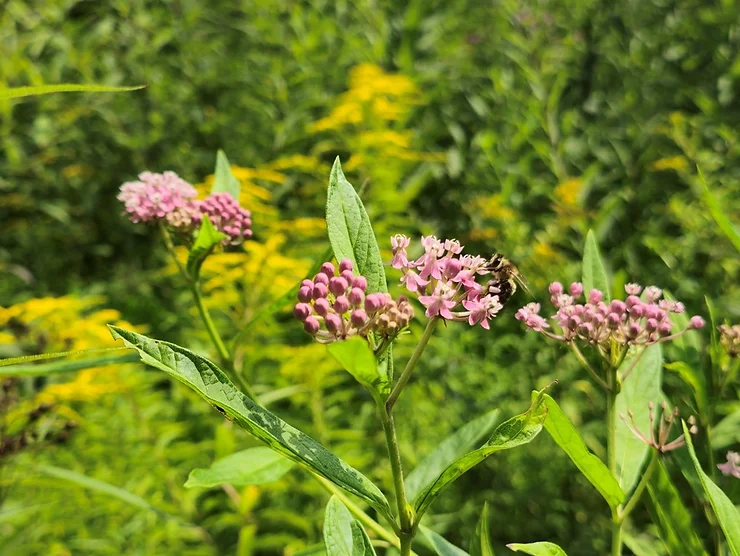
Bumblebee on milkweed
Our native ecosystems are in peril, the systems that support us in so many ways, from maintaining clean water, soil, and oxygen, sequestering and storing greenhouse gases, to providing food and materials. Much of this is due to human population growth and corresponding habitat loss. And while extinction rates are now 1,000 times the normal rate (De Vos, et. al., 2014) (Pimm, et. al., 2014) conservation efforts worldwide have thus far set aside a little more than 15% of the Earth for habitat. Experts say we need to triple that in order to preserve more than 80% of the Earth’s species. If we don’t do this, we will lose more than 50% of the species that are left. (Wilson, 2016) Many of us believe this is the moral thing to do but don’t really feel that we as individuals can make much of a difference in the small patch of the world that we call home, especially if we’re surrounded by lawns and buildings. But maybe there is something that we can do.
According to Doug Tallamy, “If American’s replanted half of their lawns with native plants, shrubs and trees, we would have more wildlife habitat than all the national parks combined.” (Tallamy, 2020) We’re not talking about wildlife habitat for species we typically think of when hearing this term, no bears or majestic eagles here, although they could reap the benefits, too. Rather, we’re talking about habitats to support species that form the backbone of every native ecosystem and drive the processes that produce the benefits and services that we need to survive. We’re talking about invertebrates and more specifically, insects. While some loathe the little buggers, we wouldn’t be alive without them, and they need our help. Over the past century, insect populations have been negatively impacted by pesticides, habitat loss, invasive species, light pollution, and climate change. Scientists refer to these impacts as “death by a thousand cuts.” (Wagner, et. al., 2019) According to a major scientific review, insect biodiversity is threatened worldwide with dramatic rates of decline heading toward the extinction of 40% of the world’s insect species. Lepidoptera and Hymenoptera (i.e. caterpillars & pollinators) are among the groups most affected. (Sánchez-Bayo & Wyckhuys, 2019)
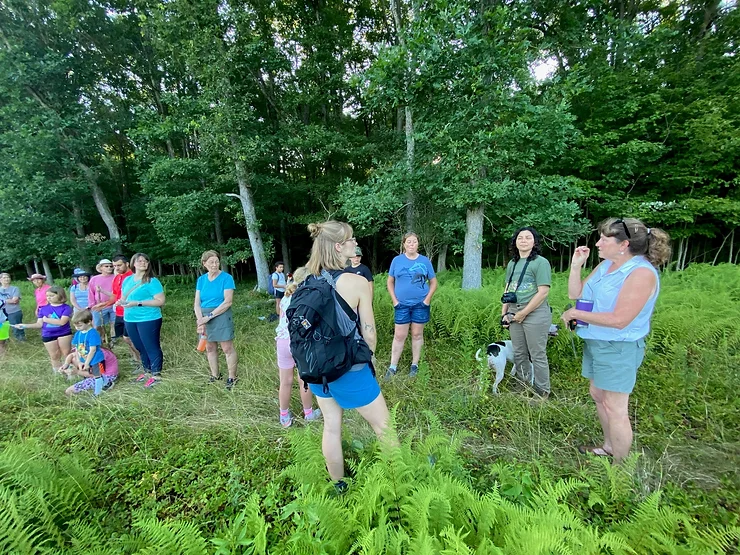
Why should we care about these declines? Pollinators are critical for maintaining plant diversity. At least 80% of all plants and 90% of all flowering and fruiting plants rely on pollination. What about the economy? Even in terms of dollars and cents, the importance of pollinators and maintaining pollinator diversity cannot be overstated. Just considering bees, both wild and managed populations, the value to global crop production has been estimated at $518 billion per year. (IPBES, 2016) Ironically, intensive agriculture is thought to be one of the primary drivers of pollinator population declines. (Raven & Wagner, 2021) What about caterpillars? Don’t they just eat and defoliate trees? Well, possibly with respect to introduced species, like the spongy moth who have few if any natural enemies to keep their populations in check. Native caterpillars, however, have evolved over time along with the species that have learned to capitalize on them as a food source. Nature has created an effective system of checks and balances. Caterpillars are essential to terrestrial food webs, transferring more energy to other animals than any other plant-eating insect. (Tallamy, 2021) In turn, the ripple effects of moth and butterfly population declines are being felt up the food web, especially with bird populations. Over 95 percent of terrestrial birds in North America feed their young insect larvae (i.e., caterpillars) and not just one or two. Carolina chickadees, for example, must catch between 6,240 and 9, 120 caterpillars to successfully rear one clutch. Today, there are 3 billion fewer breeding birds than there were 40 years ago, and 432 species of North American birds are threatened with extinction. (Tallamy, 2021)
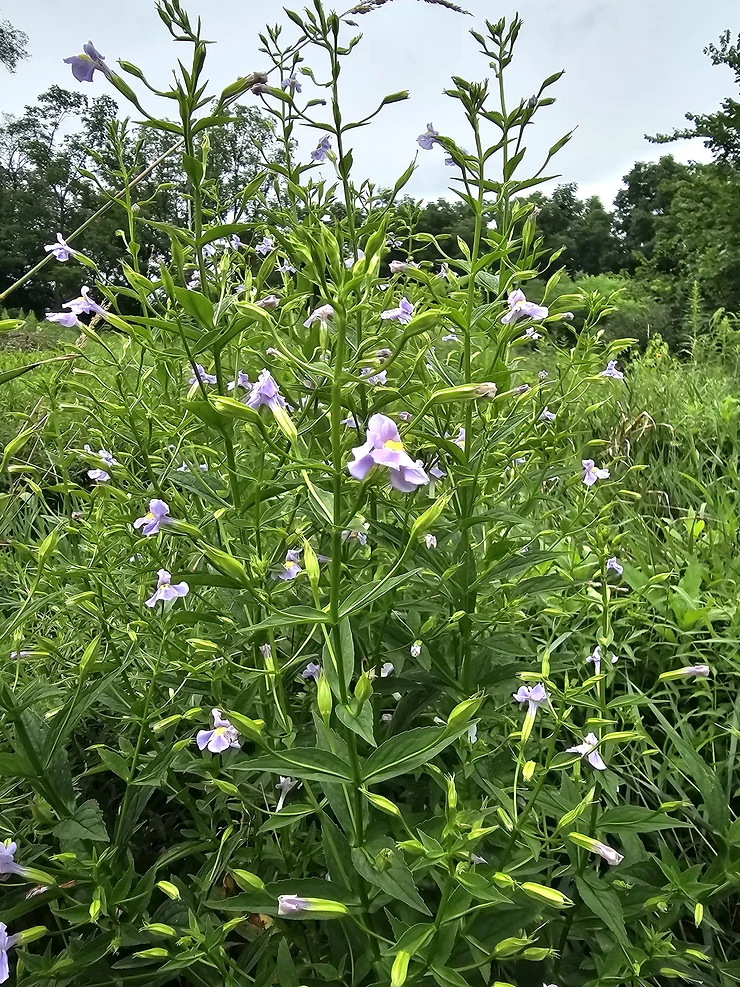
Allegheny Monkeyflower (Mimulus ringens)
So why are native plants so important to saving our pollinators and caterpillars, not to mention all the other species of animals that depend on them? Obviously, plants provide the pollen, nectar, and leaves that support them, but what’s so special about the natives? Actually, lots of things, but for now we’ll just touch the tip of the iceberg. First, let’s return to evolutionary biology. Insect and plant communities that have evolved together over time in the same locale have developed special relationships that capitalize on the specific traits or characteristics of one another. Specialized wild bee species, for instance, have co-evolved with species of flowering plants so that the spacing of hairs on their legs and abdomen match the nooks and crannies on the pollen grains, making them much more efficient at transferring pollen from these plants than other species. (Tallamy, 2021) Exotic invasive species, however, have been taken out of the locality where they evolved and plopped in the middle of a foreign land. Without natural competitors or predators to contain them, they often spread and take over, crowding out native communities. In the case of plant and insect associations, native insects prefer the plants they evolved with rather than the new kids on the block that taste funny. It is estimated that 90% of moth and butterfly species larvae have specialized host associations, meaning their caterpillars can only feed on certain plants. (Wagner, et. al., 2021) Even generally speaking, native caterpillars prefer native plants. Tallamy and others measured caterpillar communities in Pennsylvania and nearby states and compared populations between hedgerows composed primarily of native shrubs and hedgerows that had been invaded by autumn olive, multi-flora rose, and other non-native shrubs. They found a 68% reduction in species richness, a 91% reduction in abundance, and a 96% reduction in biomass in the invasive-dominant hedgerows compared to hedgerows with more native plants. (Tallamy, 2021)
Now that we’ve established the importance of native plants, how do we go about repopulating native communities across the landscape to safeguard wildlife habitat and support biodiversity? Back to the backyard and how it can help. With more than 85% of the land east of the Mississippi under personal land stewardship, making wise choices about our home landscapes can make a huge positive impact. Let’s save the topic of controlling invasive species for another time and focus on plant choices. In my case, I’ve been lucky to work with an area that still maintains remnants of the native community along with its seedbank. Sometimes, all I have to do is remove the competition and let the native species reclaim their territory, although I do supplement with new plants to add diversity. But how do we know for sure if the plant that grows back or the one that we buy is native and beneficial?
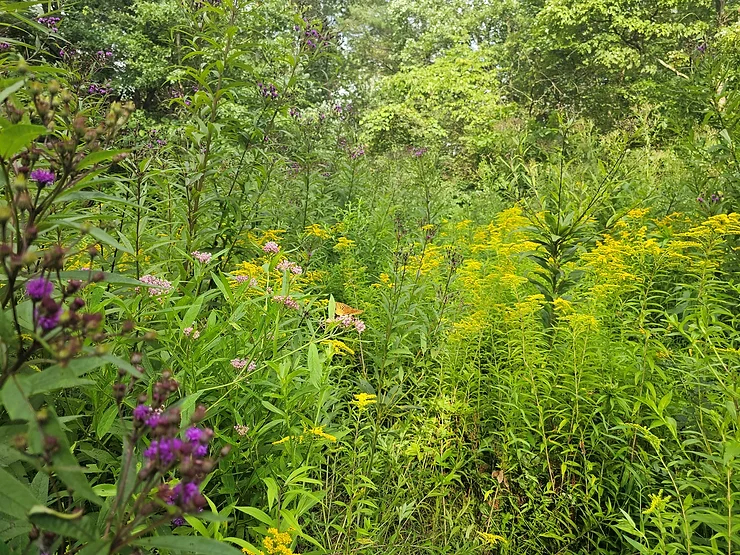
Fritillary on Milkweed
Many of us don’t know where to start, what to plant or where, how to know if a species is a good native or a problematic exotic. Then, after we’ve figured out what to plant, we can’t find it anywhere! Sometimes, in spite of our best efforts, the reality of going native seems like an uphill battle. But there are lots of resources out there to get us up and over that hill, and that’s where this newsletter comes in. This is the first of several quarterly editions designed to help us take action by reconsidering our landscaping practices and adopting more ecological friendly approaches that recognize the critical role of native plants and backyard landscaping in maintaining healthy ecosystems. Each article will dive into specifics, like who we can learn from or go to for help, what species to plant or to avoid, where to find them, when to plant them, and how to do it. Today, we’re going to round out this article with a brief introduction to keystone plants, why they are an important component to backyard native landscaping, and how to find them.
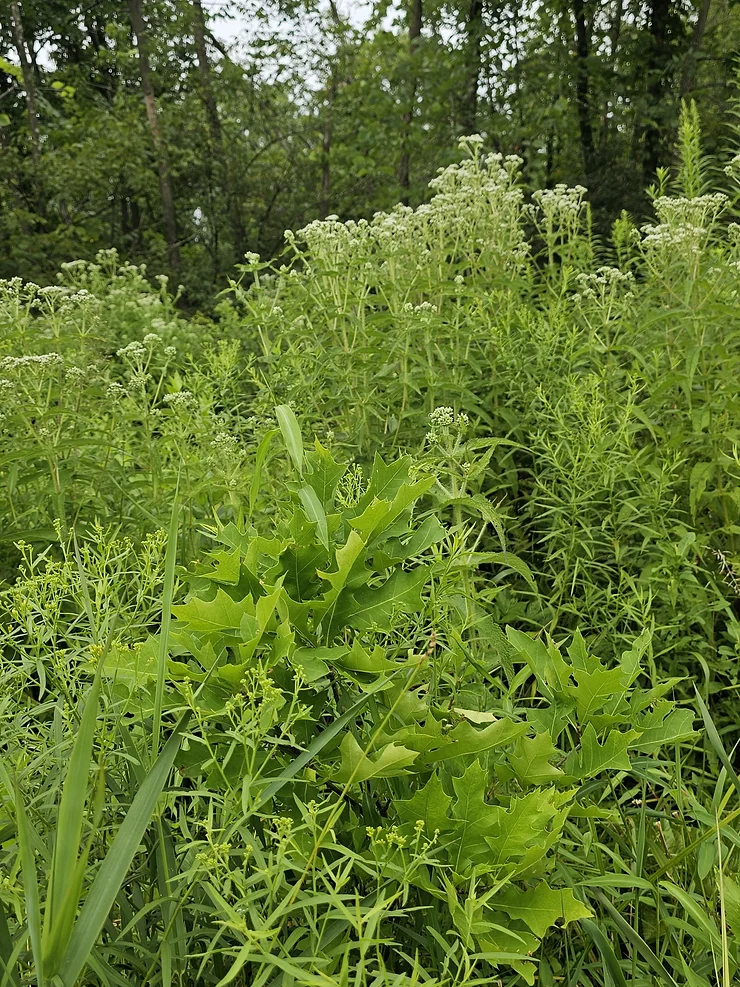
Pin oak seedling (Quercus palustris), flat-top golden rod (Euthamia graminifolia), and common boneset (Eupatorium perfoliatum).
What are keystone plants? Keystone plants have a disproportionately large impact on their environment relative to their abundance. Huh? This basically translates to, “all natives do not support insects equally well, and keystone plants do the heavy lifting.” In fact, 2/3rds of the caterpillar biomass driving food webs are supported by just 5% of our native plants. For example, oaks (genus Quercus) support 557 species of caterpillars in the mid-Atlantic region and over 950 species in the United States. (Tallamy, 2021) These hyper-productive plants are called ‘keystone plants’ and planting them in the backyard, back forty or anywhere else across the landscape will support the most species. Note that, in addition to keystone species, we should also focus on plants that serve as host specialists for particular species, the most famous of which was touched upon above with the genus Asclepia (milkweed) and the monarch butterfly. But we’ll save this important topic for a later date.
Much of the information in this article comes from Doug Tallamy, a prominent entomologist, ecologist, and conservationist living in southeastern Pennsylvania no less! Doug’s research on the interactions between plants and insects, and the impact of non-native plants on local ecosystems, along with his own backyard journey, has made him a strong advocate and sought-after speaker and teacher for “Bringing Nature Home” to our backyards and local landscapes. And above all, Doug and his wife, Cindy, are a living testament to the success of suburban backyard restoration. Doug has written several books and is a sought-after speaker where he shares his expertise on the importance of native plants and biodiversity, including information about native keystone plants for wildlife, the topic of this article. To learn more about Doug Tallamy and his work, I highly encourage you to check out his website Homegrown National Park. Be sure to check out other additional resources at the end of this article, too!
In the YouTube video titled “Native Keystone Plants for Wildlife,” Doug Tallamy discusses the importance of native plants in supporting local ecosystems. He explains how keystone plants, those that have a disproportionately large impact on their environment, are essential for maintaining biodiversity. Tallamy emphasizes that planting native species helps sustain local wildlife, including insects and birds, and can counteract the negative effects of habitat loss and climate change. This is a very informative video. In fact, many of the statistics cited above came from this video! It also includes information from the National Wildlife Federation (NWF) about their Garden for Wildlife Program to create Certified Wildlife Habitat and how to find Keystone Plant Lists for your ecoregion. You can download the list for our ecoregion, Eastern Temperate Forests, and learn more about which plants support the most species of caterpillars and pollen specialists. For more details, watch the video here.
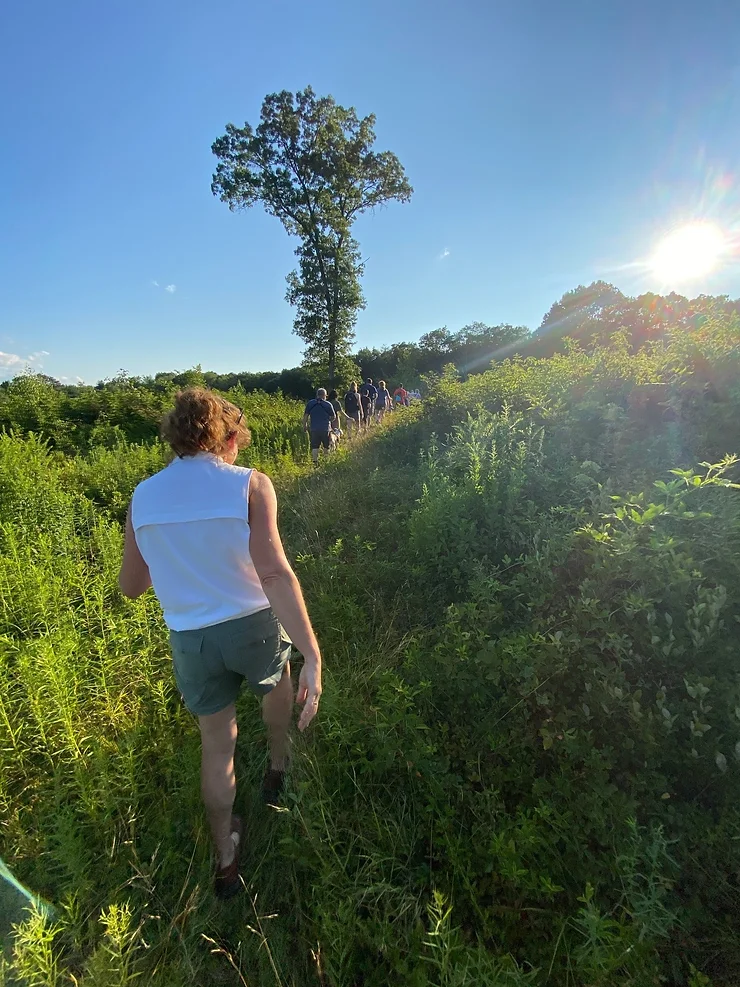
Other resources that can help us choose what to plant, where to plant it, and where to find it include:
Native Plant Finder (https://nativeplantfinder.nwf.org/Plants/Flowers-and-Grasses)
This online tool developed by NWF and Doug Tallamy, emphasizes keystone plants that are best suited for your area. Enter your zip code and the tool will give you a list of native plants, starting with flowers and grasses, ranked by the number of butterfly and moth species that use them as host plants.
Wild Seed Project (https://wildseedproject.net/buy-native-plants)
The Wild Seed Project is a non-profit organization dedicated to increasing the use of native plants in public and private landscapes. Their website contains a directory of nurseries where you can buy native plants, as well as a complete resource guide on what to look for and important questions to ask when you are there. In addition, they provide a range of other resources to support individuals and communities in their efforts to restore native plant habitats and conserve genetic diversity through seed-grown practices.
Native Plant Center – Chesapeake Region (www.nativeplantcenter.net)
This guide created by The Alliance for the Chesapeake Bay and the U.S. Fish & Wildlife Service includes information, including photos, on native species appropriate for planting in the Bay watershed, along with tips on where to find them and how to choose the best ones for you. It’s a bit outdated (the 4th printing was 2012), but very user-friendly.
Ernst Seeds (https://www.ernstseed.com/)
Ernst Seeds is a prominent and trusted provider of native and naturalized seeds and plants for restoration, conservation, and reclamation projects. Their annual catalog is loaded with information, including planting guides for different sites (e.g., pollinator-friendly sites, wet meadow & wetland sites), as well as guides on establishment and obstacles to success. They are located in Meadville, PA. Orders must be at least $25 and purchased by the pound.
Native plant sales (https://www.dcnr.pa.gov/Conservation/WildPlants/LandscapingwithNativePlants/BuyNativePlants/Pages/default.aspx)
Many local organizations and state parks hold native plant sales, typically in the spring. PA’s Department of Conservation and Natural Resources’ webpage above contains listings of opportunities and places throughout the state that specialize in native species. The Chesapeake Bay Program’s Keystone Ten Million (K10) Trees Partnership will even provide them for free!
This is not an exhaustive list, and it does not guarantee success. Please don’t get discouraged if you come up empty handed. Remember, as more people request native species, the demand for native plants will grow, more nurseries will find it feasible, even profitable, to grow them, making native plants easier to find and identify.
We’ll go into more detail about different types of keystone plants, where and how to plant them, and what species they support in later issues. For now, I hope you’ve enjoyed reading this article and found some useful resources and sparks of ideas to help you share your space with the little things that run the world. As for me, I’ll savor the little victories, like finding a new species in the ten acres I call home. This year it was Allegheny monkeyflower (Mimulus ringens). I wish you luck with your own small victories!
Link to ORIGINAL ARTICLE.
Cited References:
De Vos, J. M., L. N. Joppa, J. L. Gittleman, P. R. Stephens, and S. L. Pimm. 2014. Estimating the normal background rate of species extinction. Conservation Biology 29(2):452-462. https://doi.org/10.1111/cobi.12380.
IPBES, The assessment report of the Intergovernmental Science-Policy Platform on Biodiversity and Ecosystem Services on pollinators, pollination and food production, S. G. Potts, V. L. Imperatriz-Fonseca, H. T. Ngo, Eds. Secretariat of the Intergovernmental Science-Policy Platform on Biodiversity and Ecosystem Services, Bonn, Germany, 2016.
Pimm, S.L., C. N. Jenkins, R. Abell, T. M. Brooks, J. L. Gittleman, L. N. Joppa, P. H. Raven, C. M. Roberts, and J. O. Sexton. 2014. The biodiversity of species and their rates of extinction, distribution, and protection. Science 344(6187). 10.1126/science.1246752.
Raven, P. H. and D. L. Wagner. 2021. Agricultural intensification and climate change are rapidly decreasing insect biodiversity. Special Feature: The Global Decline of Insects in the Anthropocene. Proceedings of the National Academy of Sciences 118(2).
Sánchez-Bayo, F. and K. A. G. Wyckhuys. 2019. Worldwide decline of the entomofauna: A review of its drivers. Biological Conservation. 232:8-27.
Tallamy, D. 2020. Nature’s best hope: A new approach to conservation that starts in your yard.
Tallamy, D. 2021. Native Keystone Plants for Wildlife. Pollinator Week Webinar, Garden for Wildlife by the National Wildlife Federation, June 21, 2021. https://www.youtube.com/watch?v=O5cXccWx030.
(3) Wilson, E. O. 2016. Half Earth: Our planet’s fight for life. Liveright Publishing Corporation, New York, NY.
Wagner, D., E. M. Grames, M. L. Forister, M. R. Berenbaum, and D. Stopak. 2019. Insect decline in the Anthropocene: Death by a thousand cuts. Special Feature: The Global Decline of Insects in the Anthropocene. Proceedings of the National Academy of Sciences 118(2).
Wagner, D. L., R. Fox, D. M. Salcido, and L. A. Dyer. 2021. A window to the world of global insect declines: Moth biodiversity trends are complex and heterogeneous. Special Feature: The Global Decline of Insects in the Anthropocene. Proceedings of the National Academy of Sciences 118(2).


